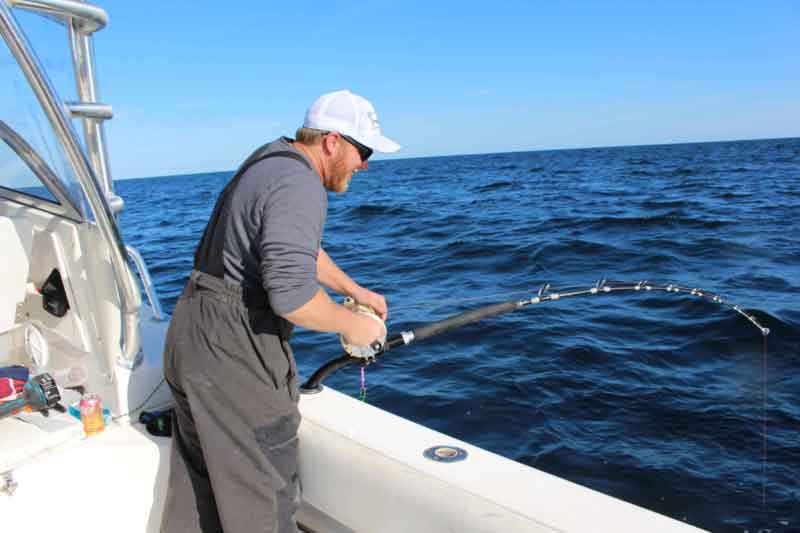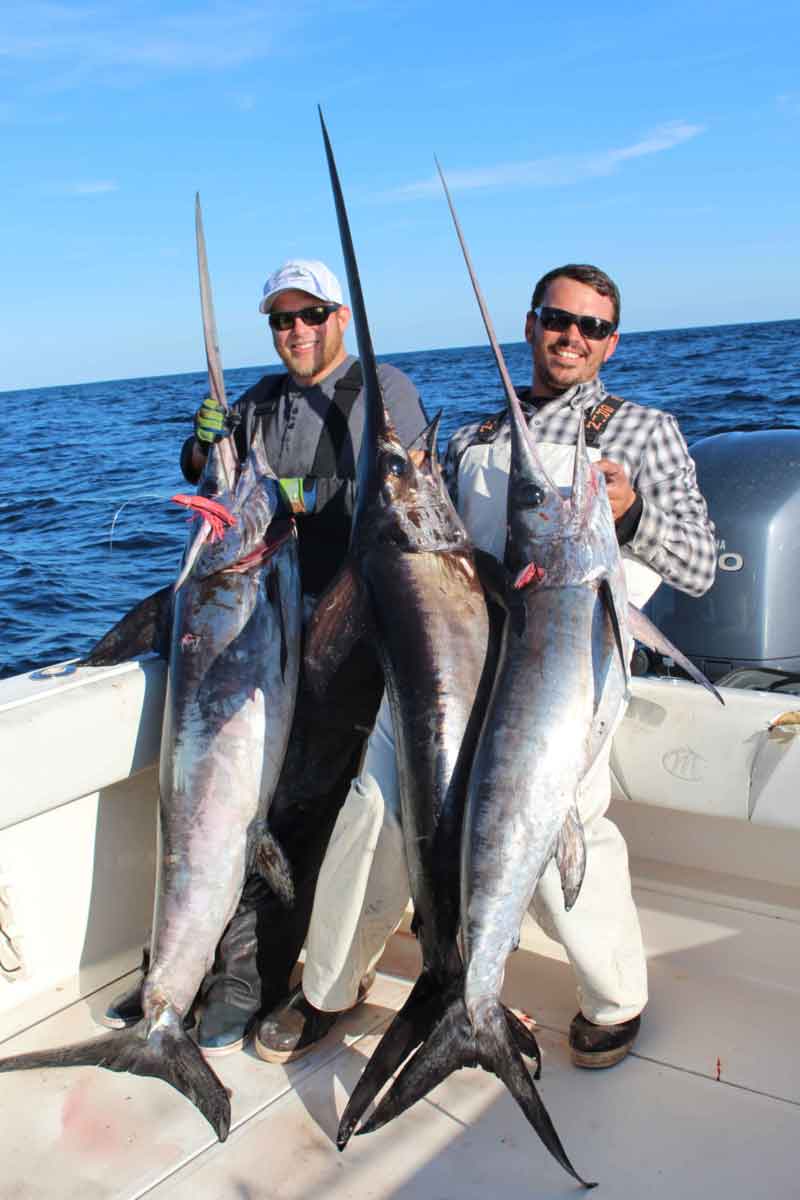Swordfish fishing used to be a game of over-nighting, but during a daytime sword trip last fall... Eleven. We got 11 bites, caught seven swordfish, and killed three legal beasts which barely fit into the coffin-sized fishboxes on Derek’s boat. Eleven sword bites, in one day of fishing near Washington Canyon. That. Is. Epic.

By any measure, swordfish action like this is world-class — yet it took place right here in our own corner of the world, in the Mid-Atlantic region. Don’t ever let any Floridian brag on how much better their fishing is than ours, because that’s a bunch of hooey. Depending on the species and the time of year, of course, what we have here at our doorstep simply can’t be beat. Period. And this daytime fall sword bite is the latest example.
How did this come to pass? I got schooled by a kid named Josh Lowery, who currently mates full-time out of OC. (Yeah Josh I’m calling you a kid even though you’re now well past legal drinking age — call it an old guy’s prerogative since your first cobia and your first bluefin came on the decks of my boat). Josh in turn credits Matt Crim, James Coats, and Victoria Crim Roberts, of the Longshot, for developing the dropping technique and proving its effectiveness. What have these folks discovered? Plenty.
First things first: the tactics we’re going to talk about here require very specific gear and very specific applications. Trying to “fake it” is likely to lead to mind-bending tangles with hundreds of feet of line involved, missed opportunities, and empty fishboxes after very long cruises. If you don’t have the right gear and can’t wrap your head around how all this works, we’d strongly recommend taking a charter that has this drill down-pat. We also want to point out that the fall season brings with it stiff breezes and rough days. Only thoroughly offshore-capable boats should be pressed into service for this fishery, and even with large boats, great care should be taken when deciding to make a foray into the offshore environment in October or November.
Deep Drop Swordfish Gear
Rods should be bent-butt 80 to 130 class, long enough to reach several feet off the gunwale when locked into the gimbal and angled out. (Holding a rod with 1500 feet of line attached to 10 pounds of lead is simply impossible). They also must have a soft tip, because you need to see the bite. And it’s a baby-bite, just a flick of the rod tip. The vast majority of the rods out there won’t make it easy to see, and having a rod designed specifically for sword-fishing is a must. These are pretty dang expensive, though Alltackle has a Daiwa which costs half as much as some.
Eighty-class reels spooled with 80- to 100-pound braid that changes color in regular increments, topped with 100 to 155 feet of 120- to 200-pound mono wind-on, are ideal. Cap that off with a five-foot 200- to 300-pound “bite” leader, attached via swivel to the end of the mono. Several bite leaders should be rigged and ready before you leave the dock with skirted rigged eels, strip baits, or rigged squid, on 11/0 or 12/0 J-hooks. At the 100-foot mark, you’ll want to add a loop of heavy wax rigging floss which will serve as the attachment point for a longline clip, securing a five-foot dropper with a 10-pound sash weight. At 30 feet you’ll want to attach a deep-drop LED strobe via copper (which will allow the line to pass through when the light hits the rod tip).
Since you’ll be dropping to 1000 to 2000 feet, there is naturally a bit more to talk about when it comes to the reel: yes, you do want an electric. Short of that, a line-winding device that attaches your reel to a power drill (there are a few on the market) will get the job done, but be sure to bring several spare batteries. The issue here isn’t actually fighting the fish, but how long it will take you to crank up after a missed strike or when you need to reposition the boat. Try to do it all via hand cranking and you’ll lose the better part of an hour to endlessly spinning the handle. Having electric assistance is also key when it comes to hooking the fish — but more about that in a moment.

Deploying Swordfish Baits
One of the biggest challenges of daytime sword dropping is getting your bait down to these tremendous depths without creating a ruinous tangle. Here’s the drill: First, drift for a few minutes to figure out the direction of travel. Then idle the boat forward at a couple of knots, heading into the prevailing force of wind and/or current (as established by your drift pattern), while paying out the leader. When you hit the 100-foot mark attach the longline clip with the dropper line and weight, and set it over the side. Continue moving the boat forward as you deploy the mainline, watching the color-coding to keep track of how much you let out. Every 200 feet, stop the reel for 10 or 15 seconds to remove any slack. When you have enough line out to be 100 feet off bottom, stop letting out line. At this point, the captain turns the boat towards the line, and slowly drives back towards it. When it’s nearly vertical, swing the boat so that it sits on the downwind/current side of the line. Allow it a moment or two to pendulum until it’s as close to vertical as possible, and then drop again until the weight hits bottom. Finally, crank up 100 to 125 feet and lock the reel up.
Whew! You’re down.
Swordfish Bites
Now, it becomes a game of staring at the rod tip. Sword bites are shockingly subtle, and often appear as a mere tap or two. You have to watch the rhythm of the boat’s rocking and rolling and ignore its effect on the rod, until you see that oddball, out-of-rhythm flick of the tip. The moment you see it, go into freespool (clicker on, of course), and let the weight fall until it hits bottom.
Remember: you’ve been watching the color-coded mainline to keep track of your depth, and you know how far your bait is off bottom. If it seems to hit bottom before it should, the swordfish probably has the bait and is hooked up — bring in line at maximum velocity, and if you feel additional resistance there’s a fish on the line and the fight is on. If the weight falls all the way to bottom, bring it back up 100 feet again and watch that tip again. Often the fast drop followed by the fast crank will trigger another strike if the fish missed on the first pass.
When you’re bringing in line and you feel the additional resistance of a fish, don’t expect a knock-down, drag-out fight right from the start. Much of the time the swords don’t seem to really care that you’re bringing them up from the depths and just sort of go along for the ride. When the longline clip comes up to the rod tip, you’ll need to hesitate for a moment for someone to un-clip it from the floss. This is usually when the fish makes its presence known for real. Try to make this process as seamless and as quick as possible, and know that this is the moment that all heck is likely to break loose.
Of the seven fish we caught on that epic day last fall, we were often unsure if the fish was still on the line until pausing to remove the clip. At that point, without fail, each time the swordfish came alive — one time shooting to the surface, tail-walking, and then charging the boat and attacking it with its bill. The adrenaline rush that ensued was incomparable. And if you do battle with a daytime sword this fall, you’ll experience that kind of adrenaline rush, too.

Daytime Swordfish Hotspots
Daytime swording takes place in 1000 to 2000 feet of water along the edge of the Continental Shelf. Chinks and drops in the edge (think of them like mini-canyons in or around the main canyons) that get hit by a current are ideal, so try to set up so your boat will drift either up or down along one of these edges. Note that often either the north side or the south side of a notch in the shelf can be productive, but it’s rare both will be on any given day. So if you try a drift with no bites, shifting to the opposite side of the notch is a good move.
-By Lenny Rudow